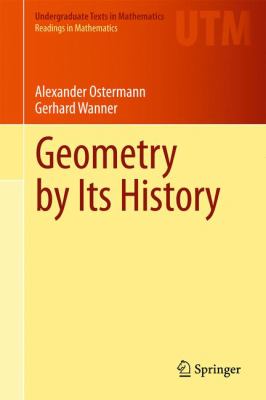Introduction to Modern Geometry - History Class Notes
Geometry by Its History,
by Alexander Ostermann and Gerhard Wanner,
Springer Verlag (Undergraduate Texts in Mathematics, 2012).

These notes would constitute part of the material of "Introduction to Modern Geometry" (MATH 4157/5157). The catalog description of this course (as of fall 2021) is: "An introduction to Euclidean and non-Euclidean geometries, emphasizing the distinction between the axiomatic characterizations, and the transformational characterizations of these geometries. Some history of the development of the discipline will also be included."
The other parts of Introduction to Modern Geometry for which I have online notes include the axiomatic method and transformational geometry.
These notes could also be used for part of "History of Mathematics" (MATH 3040). The catalog description of History of Mathematics (as of fall 2021) is: "Studies mathematics and those who contributed to its development. Recommended for teachers and those desiring to expand their view of mathematics."
Copies of the classnotes are on the internet in PDF format as given below. The "Proofs of Theorems" files were prepared in Beamer and they contain proofs of the results from the class notes. The "Printout of Proofs" are printable PDF files of the Beamer slides without the pauses. These notes and supplements have not been classroom tested (and so may have some typographical errors).
Preface. Preface notes
Part I. Classical Geometry. Part I summary
Chapter 1. Thales and Pythagoras.
Chapter 2. The Elements of Euclid. Chapter 2 notes
Chapter 3. Conic Sections. Chapter 3 notes (This includes the use of the intersection of a parabola and hyperbola to double the cube.)
Chapter 4. Further Results in Euclidean Geometry.
- Section 4.1. The Conchoid of Nicomedes, The Trisection of an Angle. Section 4.1 notes (This includes information on Pappus and his Mathematical Collection and the quadratrix of Hippias.)
- Section 4.2. The Archimedean Spiral. Section 4.2 notes
- Supplement. Archimedes: 2,000 Year Ahead of His Time. Archimedes presentation in PowerPoint and the transcript of Archimedes presentation
- Section 4.3. The Four Classical Centres of the Triangle.
- Section 4.4. The Theorems of Menelaus and Ceva.
- Section 4.5. The Theorems of Apollonius-Pappus-Stewart.
- Section 4.6. The Euler Line and the Nine-Point Circle.
- Section 4.7. Excircles and the Nagel Point.
- Section 4.8. Miquel's Theorems.
- Section 4.9. Steiner's Circle Theorems.
- Section 4.10. Morley's Theorems.
Chapter 5. Trigonometry.
- Section 5.1. Ptolemy and the Chord Function. Section 5.1 notes
- Section 5.2. Regiomontanus and Euler's Trigonometric Functions. Section 5.2 notes (This section includes a brief history of trigonometry.)
- Section 5.3. Arbitrary Triangles.
- Section 5.4. Trigonometric Solution of Malfatti's Problem.
- Section 5.5. The Stereographic Projection.
- Section 5.6. The Spherical Trigonometry of Right-Angled Triangles.
- Section 5.7. The Spherical Trigonometry of General Triangles.
- Section 5.8. The Area of a Spherical Triangle.
- Section 5.9. Trigonometric Formulas for the Conics. Section 5.9 notes
- Section 5.10. The Great Discoveries of Kepler and Newton. Section 5.10 notes
- Supplement. Feynman's Lost Lecture. (partial) Feynman's Lost Lecture notes
- Supplement. Section 13.6. Velocity and Acceleration in Polar Coordinates. Section 13.6 Calculus 3 notes (This section of Calculus 3 [MATH 2210] notes includes proofs of Kepler's three laws of planetary motion.)
Additional chapters:
Part II. Analytic Geometry.
- Chapter 6. Descartes' Geometry.
- Chapter 7. Cartesian Coordinates.
- Chapter 8. To be Constructible, or not to be.
- Chapter 9. Spatial Geometry and Vector Algebra.
- Chapter 10. Matrices and Linear Mappings.
- Chapter 11. Projective Geometry.
- Chapter 12. Solutions to the Exercises.
Return to Bob Gardner's home page

